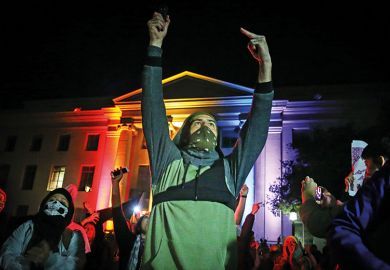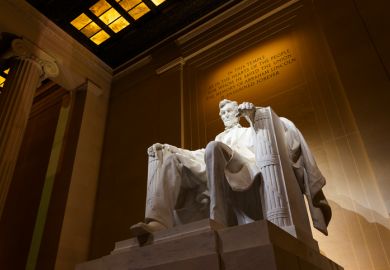US-Iran collaboration benefits the quality of research in both nations, according to data, while experts also warn that Donald Trump’s attempted travel ban ignored the scientific, economic and security benefits to America from such links.
The strength of research ties and researcher mobility between the US and Iran – one of the countries targeted by the US president’s attempted travel ban on entry for nationals from seven majority-Muslim nations via an executive order – is highlighted by figures from Elsevier’s SciVal and Scopus databases.
With anti-immigration and anti-Muslim rhetoric being adopted by right-wing populist parties in a number of Western nations, the potential for damage to a historically important scientific relationship such as that between the US and Iran is likely to concern universities around the world.
While Mr Trump abandoned attempts to overturn the legal block on his original executive order, he was due to unveil a new order this week. Seventeen of the most prestigious universities in the US, including Harvard, Yale and Stanford, had earlier filed legal papers seeking to join a lawsuit fighting the ban.
“By prohibiting persons from freely traveling to and from this country, the executive order divides students and their families, impairs the ability of American universities to draw the finest international talent, and inhibits the free exchange of ideas,” the universities wrote in their legal submission.
The Elsevier data, shared with THE, shows that US academic relationships with Iran are by far the strongest of the seven nations targeted by the order. US researchers co-authored 8,821 papers with Iranian scientists between 2011 and 2015.
That makes Iran the US’ 36th closest collaborator in research, narrowly behind the Republic of Ireland.
US-Iran co-authored papers had a field-weighted citation impact (widely regarded as an indicator of the quality of research) of 1.84. This compares with a citation impact of 1.46 for US-only authored papers and 0.84 for Iran-only authored papers. The world average is about 1.0.
Martin Edling Andersson, a senior product manager at Elsevier, said the fact the field-weighted citation impact for these US-Iran co-authored papers was higher “shows that both parties benefit”.
Medicine, engineering and physics and astronomy are the main fields in which US and Iranian researchers collaborate.
By recording the location of authors’ affiliated institutions, Elsevier’s data also suggest that about 1,500 Iranian researchers active in publications have moved to the US long term since 1996.
The average field-weighted citation impact of these Iranian researchers who moved to the US is 1.93, well above the average for researchers who remain in Iran (0.88) and marginally above the average for researchers who do not leave the US (1.92).
Another 2,900 Iranian researchers were classed as “transitory” and spending most of their time in the US in that period, with an even higher average field-weighted citation impact of 2.21.
Jeroen Baas, head of data science at Elsevier, said that its analysis has established that, worldwide, there is a “very strong correlation between international collaboration and field-weighted citation impact. You see that the impact of publications that [are published through] an international collaboration is a lot higher.”
And the ability of researchers to move around the world is a factor here.
“We’ve also seen that nations where there is a lot of mobility have a higher degree of international collaboration,” said Dr Baas.
This suggests that were the US to limit entry to Iranian nationals, it could expect to lose out in the number of internationally co-authored papers it produces and thus in the quality of its research.
Prominent examples of Iranian researchers moving to the US include Stanford professor of mathematics Maryam Mirzakhani, who in 2014 became the first woman and first Iranian to win a Fields Medal, the world’s most prestigious prize in mathematics. After an undergraduate degree at Sharif University of Technology in Tehran, she moved to the US to take a PhD at Harvard.
Another prominent Iranian-born scientist is Firouz Naderi, director for solar system exploration in Nasa’s Jet Propulsion Laboratory, who studied in US higher education after being schooled in Iran.
According to figures from the US-based Institute of International Education, Iran was the 11th largest country of origin for international students enrolling at US universities and colleges in 2015-16. Iranian student enrolment increased by 8.2 per cent to 12,269, “the highest US enrollment by Iranians in 29 years”, the IIE said in its 2016 Open Doors report. But this was still way below the peak flow of students from Iran, which was the top sender of international students to the US between 1974-75 and 1982-83, the IIE added.
After the Iranian Revolution in 1979 and the imprisoning of diplomats at its embassy in Tehran, the US severed diplomatic relations with Iran the following year. In 2015, Iran reached an agreement with six world powers – led by the US – in which it limited sensitive nuclear activities in exchange for the lifting of sanctions. However, the future of this agreement has been cast into doubt by the election of Mr Trump.
Alex Dehgan worked on developing a science diplomacy strategy with Iran under the Obama administration as senior adviser in the Office of the Special Adviser to the Secretary on the Gulf and Southwest Asia, within the US Department of State.
“Science and technology is a critical part of [Iran’s] national strategy and even the national identity, and a source of great pride,” said Iranian-born Dr Dehgan, a former chief scientist in the US Agency for International Development who is now a visiting senior fellow at Duke University and co-founder of Conservation X Labs.
While “there are many advantages to Iran for engagement with the United States…there are far more advantages for the US”, he argued.
“US engagement with the Iranian scientific community builds an important connection to the country, and…creates a scaffolding on which an official relationship [between the nations] may be built…Such engagement transcends religion, race, and culture,” Dr Dehgan said.
He added: “Science provides a common language and common values to engage Iranians in a manner that is transparent and non-threatening to the government, yet contains seeds for closer engagement and future change.
“The values inherent in science are US values, and include honesty, doubt, respect for evidence, transparency and openness, meritocracy, accountability and tolerance and, indeed, hunger for opposing points of view.”
Engagement can also give a better picture of potential risks around Iran’s “misuse of science” and prevent nuclear proliferation, Dr Dehgan argued.
He also pointed out that “many elements of the modern American lifestyle were created by Iranian-American immigrants”, citing the roles of Iranian-Americans in founding tech companies ranging from Tinder (whose co-founder, Sean Rad, is the child of Iranian immigrants) to eBay (whose founder, Pierre Omidiyar, is a French-Iranian-American).
“This is the wrong move for the United States,” Dr Dehgan said of the attempted travel ban. “It is not who we are as a nation.”
POSTSCRIPT:
Print headline: Travel ban ‘to backfire on science’
Register to continue
Why register?
- Registration is free and only takes a moment
- Once registered, you can read 3 articles a month
- Sign up for our newsletter
Subscribe
Or subscribe for unlimited access to:
- Unlimited access to news, views, insights & reviews
- Digital editions
- Digital access to THE’s university and college rankings analysis
Already registered or a current subscriber?







